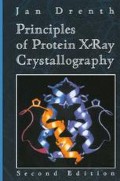Abstract
In Chapter 1 you learned how crystals of a protein can be grown and you observed a diffraction pattern. The crystalline form of a protein is required to determine the protein’s structure by X-ray diffraction, but equally necessary are the tools for recording the diffraction pattern. These will be described in this chapter on hardware. The various X-ray sources and their special properties are discussed, followed by a description of cameras and detectors for quantitative and qualitative X-ray data collection.
Access this chapter
Tax calculation will be finalised at checkout
Purchases are for personal use only
Preview
Unable to display preview. Download preview PDF.
References
Wilhelm Conrad Roentgen, 1845–1925, discovered X-rays on November 8, 1895 in Würzburg, Germany.
Max von Laue, 1879–1960, German physicist, developed the theory of X-ray diffraction by a three-dimensional lattice.
Brilliance is defined as number of photons/sec/mrad2/mm2/0.1% relative bandwidth.
Background scattering is mainly caused by the air through which the X-ray beam passes from the collimator to the beamstop. If the airpath is long and absorption serious, it can appreciably be reduced if a cone filled with helium is put between the crystal and the plate.
This instrument is discussed in detail in Arndt and Wonacott (1977).
A full circle is 2π radians.
Author information
Authors and Affiliations
Rights and permissions
Copyright information
© 1999 Springer Science+Business Media New York
About this chapter
Cite this chapter
Drenth, J. (1999). X-ray Sources and Detectors. In: Principles of Protein X-ray Crystallography. Springer Advanced Texts in Chemistry. Springer, New York, NY. https://doi.org/10.1007/978-1-4757-3092-0_2
Download citation
DOI: https://doi.org/10.1007/978-1-4757-3092-0_2
Publisher Name: Springer, New York, NY
Print ISBN: 978-1-4757-3094-4
Online ISBN: 978-1-4757-3092-0
eBook Packages: Springer Book Archive

